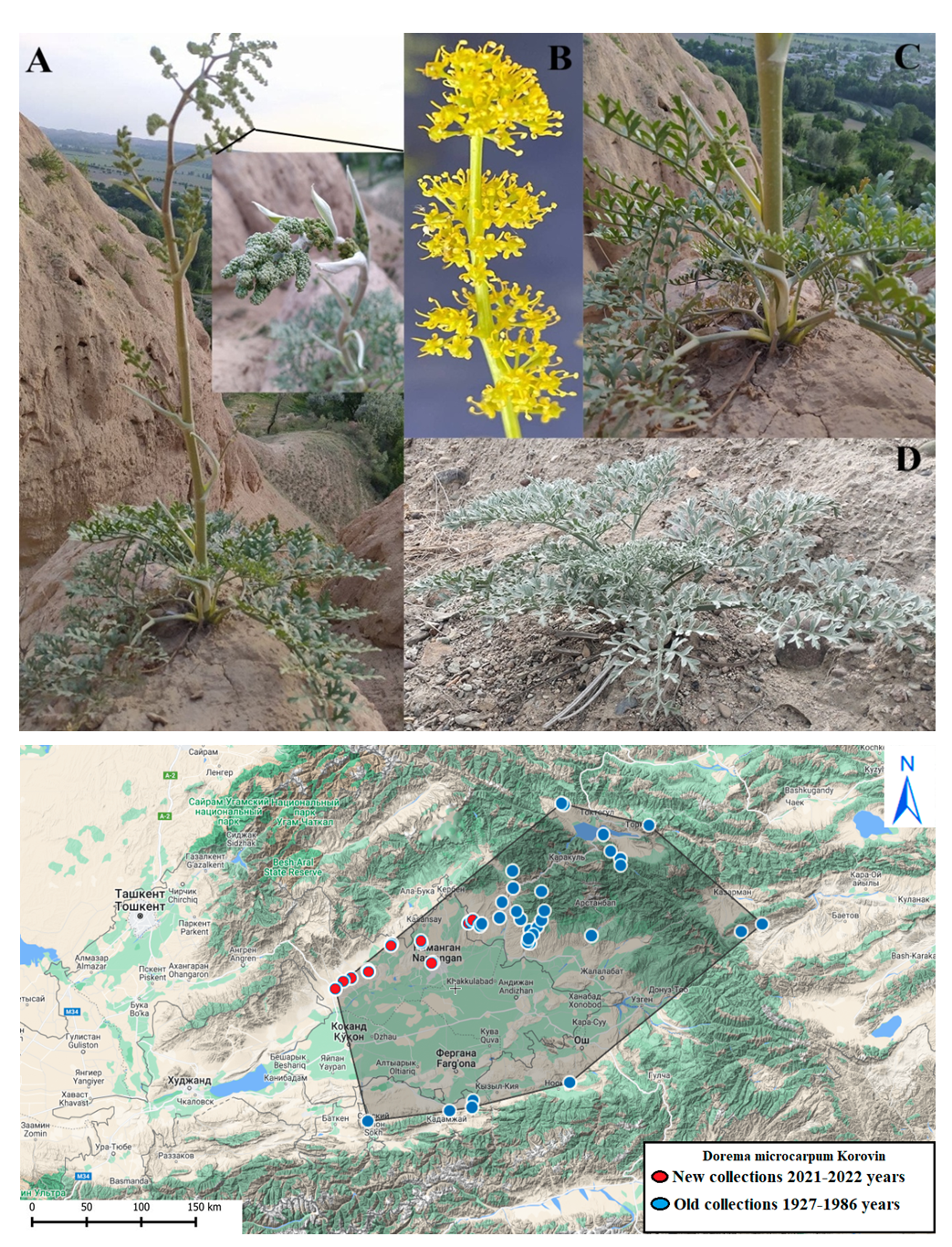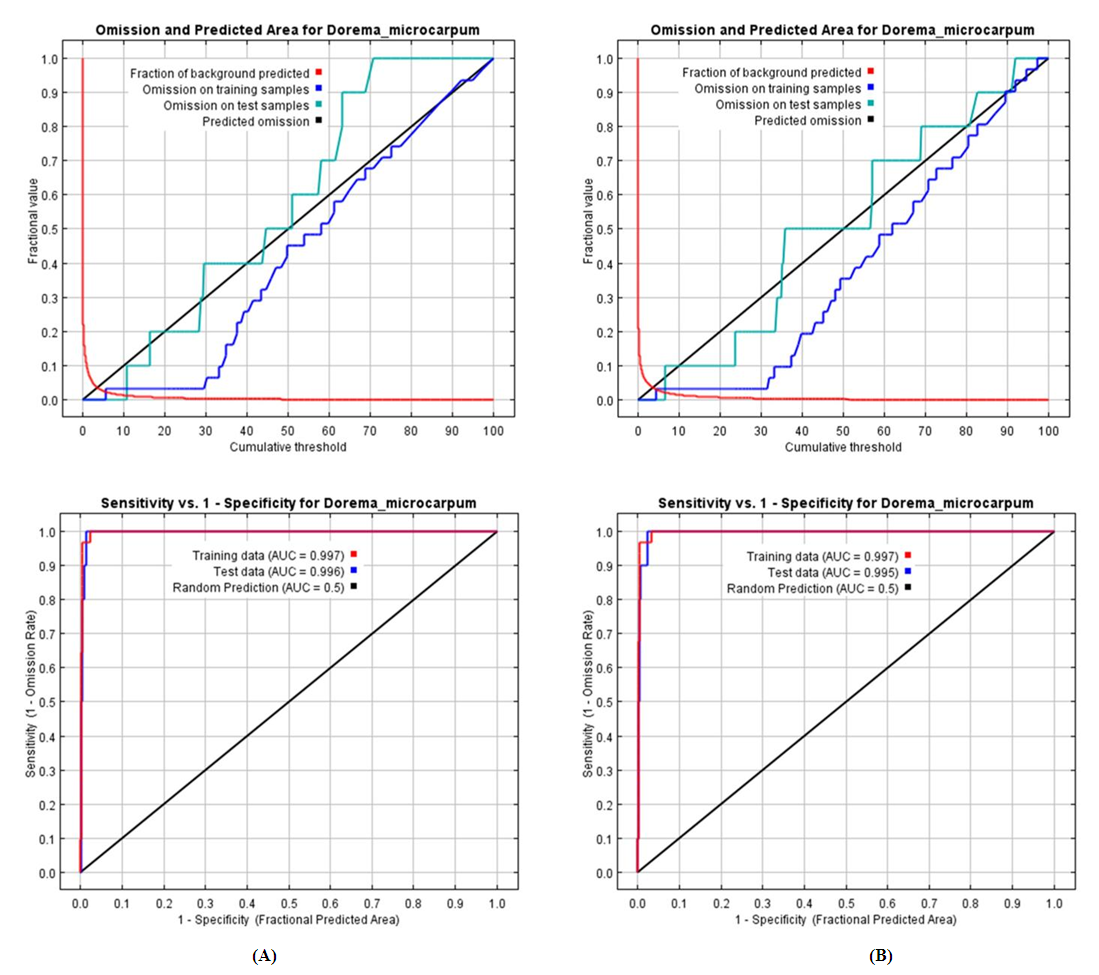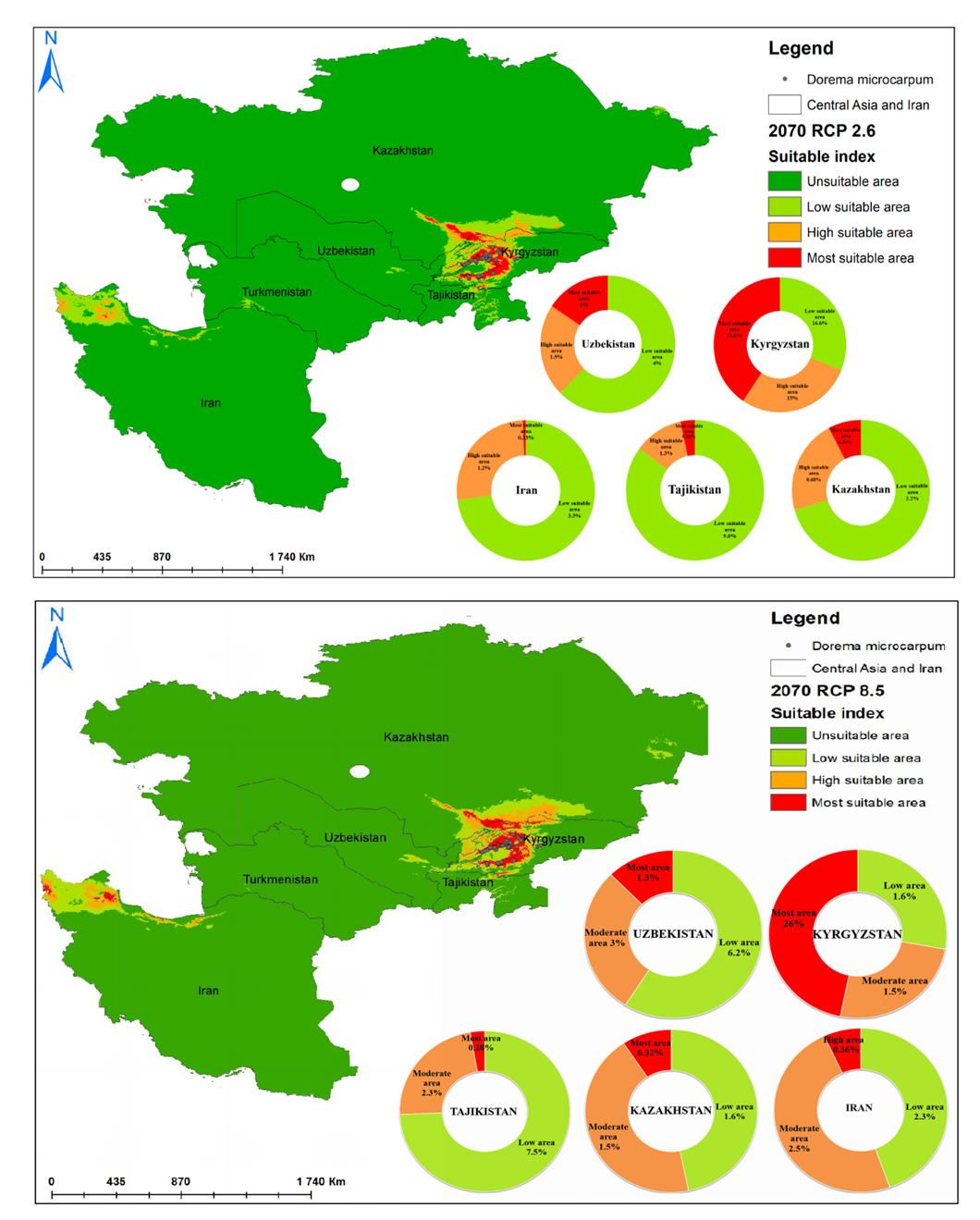-
Paper Information
- Next Paper
- Paper Submission
-
Journal Information
- About This Journal
- Editorial Board
- Current Issue
- Archive
- Author Guidelines
- Contact Us
International Journal of Virology and Molecular Biology
p-ISSN: 2163-2219 e-ISSN: 2163-2227
2022; 11(4): 43-49
doi:10.5923/j.ijvmb.20221104.01
Received: Oct. 3, 2022; Accepted: Oct. 26, 2022; Published: Oct. 31, 2022

Geographical Distribution and Bioclimatic Modeling of the Dorama Microcarpum Korovin (Apiaceae, Dorema D.Don) Species
Kh. R. Khoshimov1, R. K. Gulomov1, M. M. Mirzaolimova1, Sh. S. Abdullaev1, A. M. Ismatov2
1Doctoral Student, Namangan State University, Uzbekistan
2PhD, Namangan State University, Uzbekistan
Copyright © 2022 The Author(s). Published by Scientific & Academic Publishing.
This work is licensed under the Creative Commons Attribution International License (CC BY).
http://creativecommons.org/licenses/by/4.0/

The article presents an analysis of the results of field work conducted to study the distribution areas and ecology of the Dorema microcarpum Korovin species in the years 2021 and 2022. The MaxEnt program also performed bioclimatic modelling by combining climatic variables and geocoordinates of a species on the example of several periods (past, present and future) to assess the impact of climate changes on species populations. The simulation results made it possible to identify alternative habitats of the species, predict areas where distribution of the species is expected, consider the contribution of climatic variables affecting the potential distribution of the species, as well as analyzing possible changes in the habitat of the population in climatic condition.
Keywords: Dorama microcarpum, MaxEnt, Red Book, Endemic, Population
Cite this paper: Kh. R. Khoshimov, R. K. Gulomov, M. M. Mirzaolimova, Sh. S. Abdullaev, A. M. Ismatov, Geographical Distribution and Bioclimatic Modeling of the Dorama Microcarpum Korovin (Apiaceae, Dorema D.Don) Species, International Journal of Virology and Molecular Biology, Vol. 11 No. 4, 2022, pp. 43-49. doi: 10.5923/j.ijvmb.20221104.01.
Article Outline
1. Introduction
- Today, it is important to study and regularly monitor the current state of rare plant communities and endangered species in the world as a result of global climate change, especially a sharp increase in air temperature and anthropogenic impacts. At the same time, there is an increase in anthropogenic impact on plant communities and rare plants (Mavlanov B.J. et al., 2021). Climate change as one of the main environmental factors affecting the range of species (Kreft et al., 2007) has a negative impact on environmental phenomena, including the regional distribution and phenology of species, leading to changes in the range of species at different times, spatial scales and contributes to their disappearance or spread (Pounds et al., 2006).Nowadays, as a result of the impact of environmental factors and human activity, serious damages is being done to natural chains, and through them to the gene pool of plants. As one of the densely populated (300–400 people per 1 km2) regions of the Fergana Valley (CEPF, 2017), the reduction of the natural landscape, under the influence of anthropogenic factors is of particular importance in Central Asia due to the urgency of the problem of conservation of rare and endemic species.In the case of rare species common in the Fergana Valley, the species Dorema microcarpum Korovin with weak areas of growth was selected in order to identify, preserve the influence of anthropogenic factors, study medicinal properties and create plantations. Nowadays, targeted research work is underway on this species for 2022–2024.Historically, the main populations of this species were distributed over the plains, foothills and low mountains of the Fergana Valley (Tojibaev K.Sh., 2022). D. microcarpum is distributed in the central and southwestern parts of the Tian Shan and in the northern part of the Alai Range. It is usually found in small areas alone on hilly, gypsum, loamy and gravelly slopes of different heights of hills, mountains and foothills, at altitudes of 500–2000 m. Listed in the Red Book of Uzbekistan (2019) and Kyrgyzstan (2006). Among the published scientific sources are Pimenov M.G. (1988), Pimenov M.G., Klyuikov E.V. (2002), the study of Tojibaev K.Sh., (2012) is of great importance.D. microcarpum was first discovered from the territory of Uzbekistan in the Fergana Valley in 1928 by Ioffe A.F. (Fergana Valley. The northern city of Namangan, between Kokanbay and Tergachi. Among the crops of wheats, № 278, 279. 12.06.1928) and in 1938, Kudryashev S.N., Krasovsky P., (West Tian Shan. Foothills north of Namangan. Hills north of Namangan. The surroundings of the village of Chash–tube, rocky slopes. № 31. 07.04.1933). The results of all botanical research conducted in these territories from 2012 to 2019 showed that these species populations were considered extinct for a long time as a result of human occupation of the earth. In 2012, as a result of research conducted by Tojibaev K.Sh. in the foothills of the Kuramin ridge of the Fergana Valley, new growth points of the species Dorema microcarpum and Mogoltavia sewerzowii were identified (Tojibaev K.Sh., 2012).According to the results of the analysis, it was found that researches weren’t conducted to find new places of growth of the species, determined its chemical composition and bioclimatic modeling.In this regard, during the targeted field studies conducted in 2021–2022, the results of bioclimatic modeling of new zones of growth and potential distribution of the species were presented.
2. Material and Methods
- Species records data. To determine the location of a GPS species from the database of the Global Biodiversity Information Service (www.//gbif.org/), herbarium samples stored in the fund of the National Herbarium of Uzbekistan (TASH), samples of a virtual herbarium from Moscow (MW) (https://plant.depo.msu.ru) and Plantarium–online plant identification guide (https://www.plantarium.ru/). The geographical coordinates of the growth points of herbarium specimens were obtained using Google Earth Pro 7.1 (https://www.google.com/earth/) and supplemented with data collected as a result of field research in the Fergana Valley (Central Asia) in the years 2021 and 2022. The ASC format results obtained in MaxEnt were imported into ArcGIS 10.6.1 and distribution maps were created. The international geological coordinate system WGS 1984 (World Geodetic System 1984) was used to create the maps. Scientific prediction of the future potential distribution of endemic and rare species using the MaxEnt method and the influence of bioclimatic factors by S.J. Phillips et al., performed on the basis of methodological recommendations.Enviromental data. Data on climate variables were downloaded from the WorldClim 2.1 database (https://www.worldclim.org/). Various climatic scenarios are used to simulate the distribution of species using the MaxEnt program. They are derived from 2.5–minute (~4.64 km) scenarios of shared socio–economic roads (SSPs) that exist based on the global climate of CCSM5 (Gent et al., 2011).To date, scientists have widely used four scenarios (RCP 2.6, RCP 4.5, RCP 6.0, RCP 8.5) RCP (representative concentration trajectories), climate scenarios of the latest generation (Stocker T. et al., 2013).Of the available scenarios, priority is given to the RCP 2.6 2070 scenario (SSP1–2.6 (sp 126) minimum greenhouse gases), RCP8.5 2070 (SSP5–8.5 (ssp585) maximum greenhouse gases). According to the Fifth IPCC Report (AR5), the average annual air temperature rises in the range of 0.4–1.6°C at RCP 2.6 (2070) and 1.4–2.6°C at RCP 8.5 (2070). The RCP8.5 2070 (2061–2080) scenario assumes that the amount of carbon in the atmosphere will increase by about 2.5 times at the end of the 21st century compared to today (Meinshausen, 2011). Soil organic carbon (SOC) is the largest source of carbon on land, and the loss of a small amount of carbon from the soil can lead to significant changes in the concentration of CO2 in the atmosphere. This will have a serious impact on the scale of future climate change.Environmental variables analysis. Initially, 50 coordinates were saved in the *CSV(Comma Separated Values) format, then the height data was sent to the MaxEnt model (version 3.4.4) along with 19 bioclimate variables obtained after simultaneous sampling and screening to stimulate propagation was imported. The sample data were used randomly as test data (25%) and training data (75%) to improve the accuracy of stimulation. The algorithm of the results and discussion was performed using various random divisions (Bootstrap method) using 5000 iterations in 10,000 interactions. The resulting model represents the area under the curve (AUC) calculated based on the operational characteristics of the receptor (ROC).
3. Results and Discussions
- The currently available herbarium samples were analyzed and the available literature was analyzed, 50 growth coordinates of D. microcarpum species were identified (Table 1). There are 38 samples in the National Herbarium of Uzbekistan (TASN) and 12 samples at Lomonosov Moscow State University (MW). Eighteen of these herbarium samples were collected in Uzbekistan and 33 in Kyrgyzstan.
|
 | Figure 1. Specie of the D.microcarpum (A, B, C, D); Map of the distribution (A red star indicator marks the data sampled by the authors) |
 | Figure 2. Feasibility of a species prediction model (А – RCP 2.6 2070; B – RCP 8.5 2070) |
 | Figurе 3. D. microcarpum species Future (RCP 2.6, RCP 8.5) distribution range (Most suitable area “Red”, High suitable area “Orange”, Low suitable area “Light green” and Unsuitable area “Green”) |
|
 | Figurе 4. Results of the Jackknife test for environmental factor for D.microcarpum distributed in the Fergana Valley (А – RCP 2.6 2070; B – RCP 8.5 2070) |
4. Conclusions
- The results of the analysis show that the main range of the D. microcarpum species is in the central and Southwestern parts of the Tian Shan and in the north of the Alay Ridge. The climatic factors optimal for this species, as noted, are adequate temperatures and annual precipitation. The simulation results are used to analyze rare and endangered species, monitor them for a long period of time and determine the ecological viability of the species. The determination of the ecological optimum of the species will allow the successful introduction of these species in the future. In addition, information about rare and endangered species will be used in future editions of local Red Books.
ACKNOWLEDGEMENTS
- We would like to thank the researchers of the Institute of Botany of the Academy of Sciences of the Republic of Uzbekistan for their practical assistance in using the samples stored in the National Herbarium of Uzbekistan (TASH).
 Abstract
Abstract Reference
Reference Full-Text PDF
Full-Text PDF Full-text HTML
Full-text HTML
